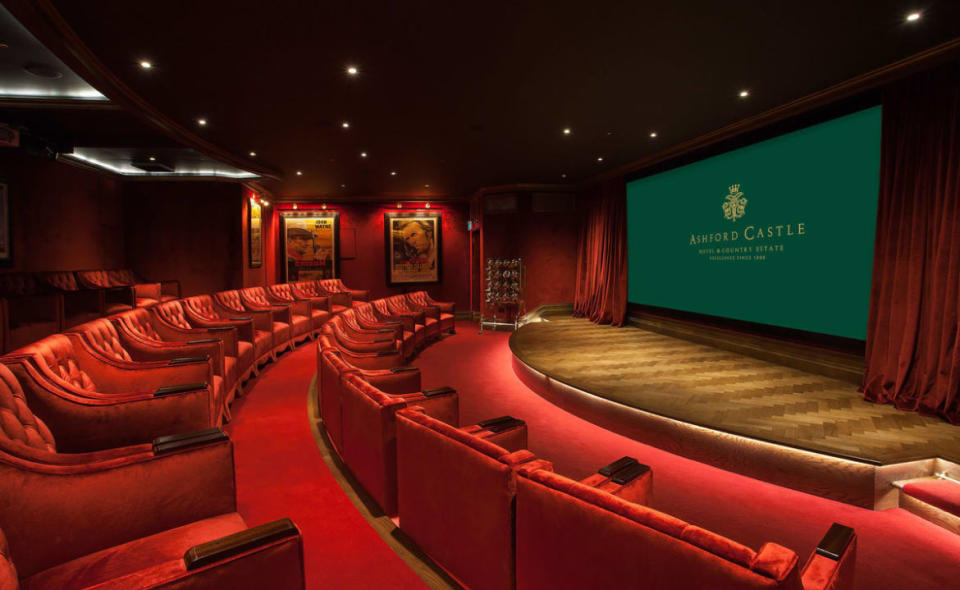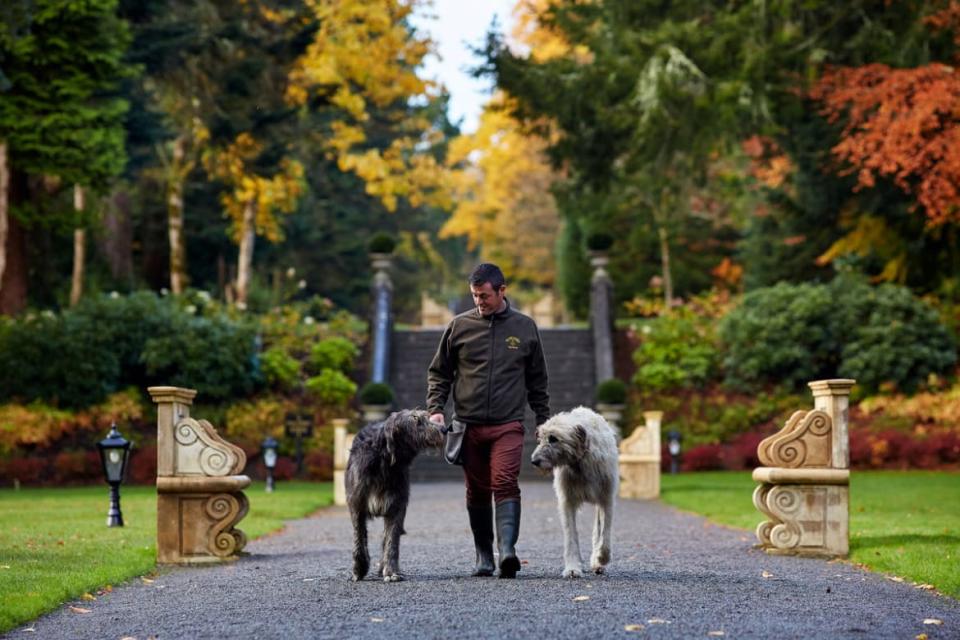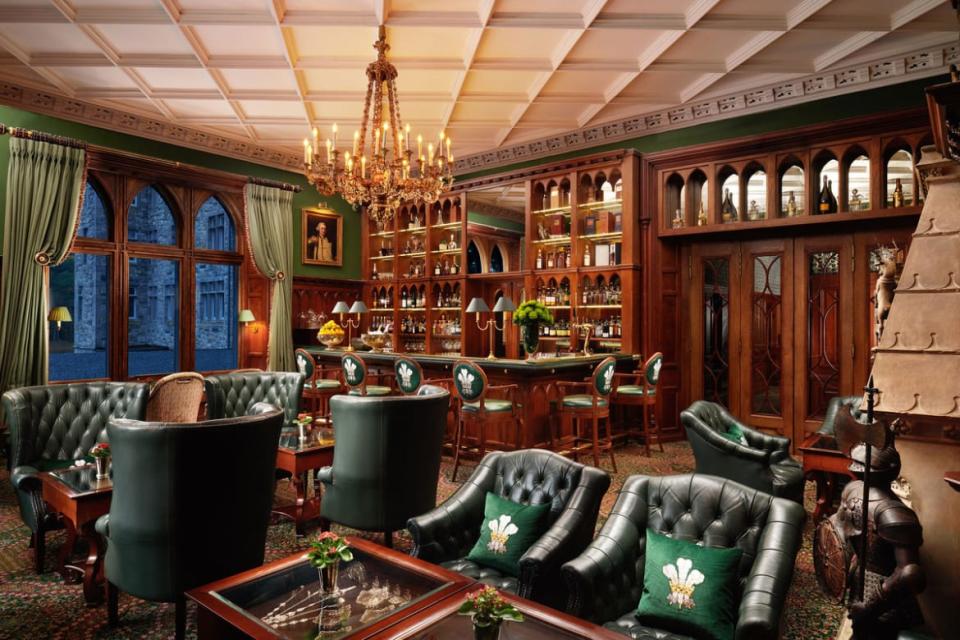Ireland’s Ashford Castle Wants You to Live Like Royalty

I must admit, it’s nice to know the exact coordinates of the lap of luxury: 53°32′04″N 9°17′06″W. Or, to spell it out, Ashford Castle, the hotel and resort just outside the town of Cong, County Mayo, in the Republic of Ireland.
I recently spent five nights there, and my only complaint is that I didn’t spend six. Unlike most hotels of my acquaintance, it was not a place I left willingly. In similar fashion, it upended my vocabulary. Luxury and pampering are words that make my lapsed-Presbyterian soul squirm with a sort of “get thee behind me, Satan” shiver. Usually. But then, after my time at the castle, I had to wonder if I had previously encountered only hoteliers who did not know the proper methods to administer luxury or pampering (although my mental jury is still split on any kind of pampering, a word too often found in the same sentence with the word spa, a locale whose charms, even at Ashford Castle, are largely lost on me).

Good service is only part of what you get. And once you add on the quality of the food in the hotel’s several restaurants, the luxuriousness of the common spaces and the individual rooms, the usual high-end resort amenities (golf, spa), and the one-of-a-kind surroundings—336 acres of well landscaped woods and gardens, all bordering the largest lake in the Republic of Ireland—the deal starts to make sense.
Still, no hotel gets five-star ratings simply on the basis of attentive service, fine food, and an even finer thread count. There has to be something more, and in the case of Ashford Castle, the something more is twofold: history and location. The hotel’s 83 rooms occupy a building that make you feel at every turn of the stairs and every glance out of a floor-to-ceiling window as though you’ve wandered onto a Downton Abbey set (and if you can afford Ashford Castle, you may indeed be one of those people, like Violet Crawley, who cluelessly asks, “What’s a weekend?”). But it’s not a set, or not entirely. Yes, a lot of the 19th century-vintage art was picked up at estate sales, but the hotel was once a well-heeled family’s country estate, so the illusion of stepping back in time is not altogether an illusion. It’s just that now the order is inverted and it’s the servants who dress in evening attire at dinner time.
OMG, I Want to Rent That House: County Tipperary, Ireland
Once you step outside the hotel, in almost any direction, there is no illusion, or rather, illusion and reality are one. The fountains, the lawns stretching to infinity, the landscaping that here obeys a regimented order while over there letting nature loose in a romantic riot of color and shape, the paths that lead through woods to more gardens, and more graveled paths and more woods, and tennis courts, and more gardens: These shaped vistas that never stop giving way to more vistas manage somehow to sculpt spaces at once enormous and intimate, and it works on you like a tonic. Once you start on a walk, you find yourself tempted at every turn and curve to see what lies beyond. Just a little farther. And a little more. And Irish weather being what it is, you go for an hour’s stroll through this immensity and before you’re done, you’ve enjoyed all four seasons.

Ashford Castle has been a hotel since 1939. But it comes by its name honestly, for once upon a time it was a castle (the hotel’s slogan: Excellence Since 1228). Construction has been intermittent but unending since the 13th century, with a wing added here and a tower there, until sometime in the 20th century the building settled into its current shape: a rambling, gray structure topped with turrets and battlements, skirted by a moat. Built on the site of a destroyed monastery, the castle was owned and fought over by Normans, Irish gentry, and English Protestants for the better part of seven centuries before being acquired, in 1852, by the Guinnesses, the wealthy brewing family, who used a good chunk of their fortune to buy respectability and a place in high society. Ashford Castle, with its 26,000 acres of hunting and fishing, was their lure for the idle rich and assorted royals, and the bait proved sufficiently enticing to help snare Arthur Guinness a lordship.
In its life as a hotel, Ashford Castle has changed owners and fortunes several times until, most recently, it was acquired for the relatively bargain rate of 20 million euros by the Red Carnation hotel group, which quickly proceeded to pour about 75 million euros into the property to… I would say restore its grandeur, but I’m not sure it was ever this grand before.

A word here about restoring old hotels, which too often does not mean restoring so much as upgrading and modernizing, with the result that the hotel’s original character—what made you cherish it in the first place—gets all but erased. The water pressure is good, but the character’s gone missing. Let one little detail suffice: You used to be able to gauge just how high-end a hotel was by the quality of the complimentary stationery and envelopes placed in the room’s desk. Now, mind you, no one today spends a lot of time writing letters in hotels or anywhere else, and hoteliers have taken note: The last time I stayed at the upgraded Shelbourne in Dublin, they had ceased leaving any stationery whatsoever, which broke my heart, because, damn, that paper was so good you wanted to write a letter. Ashford Castle, I’m happy to report, still puts out the good stuff.
Niall Rochford, the hotel’s manager, once told a reporter, “Of the two words in the name of our hotel, ‘castle’ is the important one. That makes Ashford unique and authentic. People want to live the dream, to be king or queen for a day.”
As far as I could see, the hotel does its best to fulfill that fantasy for its guests. Service is solicitous and expert without being obsequious. The staff is friendly and helpful even when it doesn’t need to be; e.g., a porter caught me admiring one of the 19th-century paintings that line the hallways and took the time to explain how the catastrophic histories of famine and land reform were being dramatized in what was so vividly visualized: a landlord on horseback looking compassionately upon dispossessed tenants beside the road. I didn’t know whether to be more impressed by the fact that the castle would hang such a painting or that a random staffer was such a skilled and friendly interpreter.

In matters cultural Ashford Castle has an understandable if not entirely forgivable fixation with John Ford’s softheaded Irish fairy tale The Quiet Man, which was filmed, in part, on the hotel grounds and can be screened on every TV screen in every room and a couple of times a week in the hotel’s own luxurious movie theater. But for the most part, the hotel’s staff tries hard not to distort history—luckily for the hotel’s origin story, the Guinnesses and their predecessors were among the “good” landlords in the 19th-century run-up to national independence—and it does a first-rate job of celebrating regional culture.
There is a dizzying list of ways you can while away your time at the castle, including the usual (golfing, fishing, trap shooting) and the more esoteric (archery, zip-lining, horseback riding). But you would be a fool not to make your first stop Ireland’s School of Falconry, located a short walk from the hotel. When you first feel a hawk’s talons tighten on your gloved wrist, you’re suddenly glad you’re wearing that glove. Then the hawk launches from your wrist and as it rises, it’s, as though a part of you were suddenly airborne too. We’re so rarely this close to wildness, and it may sound simple to call it exhilarating, but that’s what it is.
After falconry, the coolest activity at the castle was, well, not at the castle exactly. The castle’s Meet the Makers program takes you on day trips to meet and learn from craftspeople and artisans working in the west of Ireland. Directed by Eoin Warner, a documentary filmmaker and an authority on Irish folk life, a day’s journey includes visits to at least three artisans, including fisherfolk, blacksmiths, weavers, woodworkers, story tellers, ceramicists, and organic farmers. The trip I joined included visits with basket weaver Joe Hogan, traditional flute player and flute maker Marcus Hernon and his son the fiddler Breándán Hernon, and chefs Phillipa Duff and Sinéad Foyle, who run Sea Hare, a celebrated Connemara pop up restaurant that celebrates local sourcing. And the getting there and coming back wound through the stark sun and shadow beauty of Connemara’s changeling mountain landscape, bookending a near perfect day.
Ashford Castle is selling a fantasy, but the fantasy’s constituent parts are real enough: it was a castle, it was a country estate—it would only be crazy not to trade on that. And the hotel completes its part of the bargain with first-rate service and amenities and a staff who embrace their roles so thoroughly that you never see the mask slip. Robert Bowe, the hotel’s restaurant and wine programme manager with 35 years experience on the premises, is so suavely expert at everything he does, whether giving a tour of the wine cellar or whisking the silver cloche from a newly arrived entree at table, that I began mentally describing him by using the words Wodehouse deploys to describe the inimitable Jeeves, as when “Jeeves shimmered across the room.” So it was no surprise at all that Bowe would be the keeper of the lore concerning Ivory, the little girl ghost who haunts the castle, or that he knew how to tell the story so beautifully that you couldn’t help laughing and shivering all at once. At Ashford Castle, everyone is good at what they do, right down to the ghost stories.
Get the Daily Beast's biggest scoops and scandals delivered right to your inbox. Sign up now.
Stay informed and gain unlimited access to the Daily Beast's unmatched reporting. Subscribe now.

